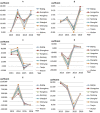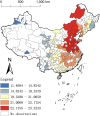Government drivers of breast cancer prevention: A spatiotemporal analysis based on the association between breast cancer and macro factors
- PMID: 36268002
- PMCID: PMC9578696
- DOI: 10.3389/fpubh.2022.954247
Government drivers of breast cancer prevention: A spatiotemporal analysis based on the association between breast cancer and macro factors
Abstract
Background: Currently, breast cancer (BC) is ranked among the top malignant tumors in the world, and has attracted widespread attention. Compared with the traditional analysis on biological determinants of BC, this study focused on macro factors, including light at night (LAN), PM2.5, per capita consumption expenditure, economic density, population density, and number of medical beds, to provide targets for the government to implement BC interventions.
Methods: A total of 182 prefecture-level cities in China from 2013 to 2016 were selected as the sample of the study. The geographically and temporally weighted regression (GTWR) model was adopted to describe the spatiotemporal correlation between the scale of BC and macro factors.
Results: The results showed that the GTWR model can better reveal the spatiotemporal variation. In the temporal dimension, the fluctuations of the regression coefficients of each variable were significant. In the spatial dimension, the positive impacts of LAN, per capita consumption expenditure, population density and number of medical beds gradually increased from west to east, and the positive coefficient of PM2.5 gradually increased from north to south. The negative impact of economic density gradually increased from west to east.
Conclusion: The fact that the degree of effect of each variable fluctuates over time reminds the government to pay continuous attention to BC prevention. The spatial heterogeneity features also urge the government to focus on different macro indicators in eastern and western China or southern and northern China. In other words, our research helps drive the government to center on key regions and take targeted measures to curb the rapid growth of BC.
Keywords: breast cancer scale; geographically and temporally weighted regression model; light at night; macro factors; temporal and spatial heterogeneity.
Copyright © 2022 Bai, Zhang, Shi, Geng, Wu, Lai, Xiang, Wang, Cao, Shi and Li.
Conflict of interest statement
The authors declare that the research was conducted in the absence of any commercial or financial relationships that could be construed as a potential conflict of interest.
Figures




Similar articles
-
The varying driving forces of PM2.5 concentrations in Chinese cities: Insights from a geographically and temporally weighted regression model.Environ Int. 2020 Dec;145:106168. doi: 10.1016/j.envint.2020.106168. Epub 2020 Oct 10. Environ Int. 2020. PMID: 33049548
-
Examining the spatially varying effects of factors on PM2.5 concentrations in Chinese cities using geographically weighted regression modeling.Environ Pollut. 2019 May;248:792-803. doi: 10.1016/j.envpol.2019.02.081. Epub 2019 Feb 28. Environ Pollut. 2019. PMID: 30851589
-
Global and Geographically and Temporally Weighted Regression Models for Modeling PM2.5 in Heilongjiang, China from 2015 to 2018.Int J Environ Res Public Health. 2019 Dec 14;16(24):5107. doi: 10.3390/ijerph16245107. Int J Environ Res Public Health. 2019. PMID: 31847317 Free PMC article.
-
Spatiotemporal heterogeneity of the association between socioeconomic development and birth rate: a geographically and temporally weighted regression modeling study in China.Front Public Health. 2025 May 21;13:1587358. doi: 10.3389/fpubh.2025.1587358. eCollection 2025. Front Public Health. 2025. PMID: 40469597 Free PMC article.
-
[Geographical and temporal weighted regression model and its application in epidemiology: a review].Zhongguo Xue Xi Chong Bing Fang Zhi Za Zhi. 2022 Oct 20;35(2):199-205. doi: 10.16250/j.32.1374.2022086. Zhongguo Xue Xi Chong Bing Fang Zhi Za Zhi. 2022. PMID: 37253571 Review. Chinese.
Cited by
-
Determining the effects of social-environmental factors on the incidence and mortality of lung cancer in China based on remote sensing and GIS technology during 2007-2016.BMC Public Health. 2025 May 6;25(1):1673. doi: 10.1186/s12889-025-22591-w. BMC Public Health. 2025. PMID: 40329282 Free PMC article.
-
Exploring the geospatial epidemiology of breast cancer in Iran: identifying significant risk factors and spatial patterns for evidence-based prevention strategies.BMC Cancer. 2023 Dec 11;23(1):1219. doi: 10.1186/s12885-023-11555-1. BMC Cancer. 2023. PMID: 38082251 Free PMC article.
References
-
- Bahari F, Ebadi P, Javaherian M, Hajian P, Mirzaei H. The effectiveness of rational - behavioral - emotional therapeutic approach accretion hope for breast cancer patients. Adv Biores. (2016) 7:32–36. 10.15515/abr.0976-4585.7.5.3236 - DOI
Publication types
MeSH terms
Substances
LinkOut - more resources
Full Text Sources
Medical

